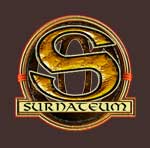|
|
Department of
Cryptozoology and Teratology
As its name implies, the Department of Cryptozoology and Teratology
studies unknown animals and monstrosities. Nothing really 'magic' about
that, except perhaps the hand of a yeti found among the instruments
of a Nepalese shaman.
The vampire collection is unique in its breadth and scope.
A rare example of archicephaloteutis virulens from the Humboldt-Fonteyne
collection was also acquired by the Museum from its owner, Mr Michel de Spiegeleire.

- Bernard
Heuvelmans
- Vampire collection (Vampires have always been
with us, ever since the dusk of time. They are predators, lying in wait for the slightest
sign of weakness. They wait in the dark and feed on our life
force. The vampire is the arch-enemy of the sensitive, his nemesis,
his total opposite.
Despite this, alliances and truces can sometimes be reached.)
- Historical Section (The great vampire
fright of the 18th century, linked to the dread
of Satanism following the Affaire
des Poisons, is first seen in Magia Posthuma, a work
by Charles Ferdinand de Schertz published in 1706. Brimming with
over-the-top exaggerations, the book tells a number of vampire tales from
Bohemia and Moravia.
The case of Peter Plogojovitz is described, among others. Monsignor
Giuseppe Davanzati (1665-1755), archbishop of Trani, wrote his Dissertazione sopra i vampiri
in 1743, refuting the existence
of vampires and contradicting the opinion of Cardinal Schtattembach,
the bishop of Olmutz, who made no secret of using Schertz's
arguments. More importantly, in 1743 Davanzati's work was
validated by a letter of recommendation from Pope Benedict XIV,
the Catholic Church's leading authority on divine and diabolical
miracles and wonders. It is now widely accepted that belief in
vampires in the 18th century was linked to the work of Dom Augustin Calmet (1672-1757).
A cautious sceptic, this priest from Sénones collected a
number of accounts in his Traité sur
les apparitions des esprits et sur les vampires ou les revenans
de Hongrie, de Moravie,&c, a book in which the Church
officially acknowledges the existence of vampirism for the first
time. Held in check for some forty years,
fear of vampires skyrocketed during the French Revolution,
which some Catholic authorities blamed on a Satanic conspiracy.
The 19th century would see the emergence of a romantic literary
movement beginning in 1819
with John Polidori novel, The Vampire. Legend has it that
the book was written at the same time as Mary Shelley's Frankenstein.
These were followed by Lord Ruthven, Carmilla by Sheridan
Le Fanu and, finally, the highly celebrated Dracula, by
Bram
Stoker.
- Vampire illustrations
- Don Augustin Calmet: Traité sur les
apparitions...
- Camazotz
- Babylonian demon bowls (These Babylonian demon bowls date
back to the fifth and sixth century AD. The incantations
inscribed inside the bowls are written in an ancient Semitic
language, Syriac, and pseudo-script. The bowl was placed
upside-down in the corner of a room because the meeting of
walls and floor created cracks where the demons could sneak in.
Lamia
and Lilith,
the first vampires, were imprisoned by the incantation. Bits of
eggshell and food were placed under the upside-down bowls,
since these creatures were very fond of it.)
- Last rites kit (USA 1897) (This last rites kit went on
sale in the United States in 1897. In case of emergency, a
priest was called for.
He could come straight to the dying person without having to
make a detour to the presbytery because everything he needed
was already there. The kit could also be used to give the last
rites to a lost soul .)
- Collin de Plancy
- Montague Summers
· The Vampire, His Kith and Kin
· The Vampire in Europe
· The Werewolf
- Dracula section (No vampire collection
would be complete without a rare edition of Dracula.
Numerous websites can be consulted for more information and a full
biography of this extraordinary Irish author .
Here, we will simply emphasise that he was a sensitive who
perceived the traits of the vampire in the strange personality of his employer,
English actor John Irving. In addition to an original photo of Sir
John Irving dressed as Mephistopheles,
the Museum possesses a handwritten letter from Bram Stoker
signed in Irving's hand, as well as the very strange pipe given
him for his role in Faust in 1885.)
-
Dracula
(Bram Stoker, 2nd US edition, 1904, green cover, extremely
rare)
- Dracula's Guest (Bram Stoker, 1st edition)
- Bram Stoker (photo and handwritten letter)
- Sir Henry Irving (photo
of Irving dressed as Mephistopheles)
- Sir Henry Irving's
Mephistophelean pipe
- Map of London (1900)
- Map of Transylvania (1789)
- The Vampire (Rudyard Kipling) (Poem written in 1897
on the occasion of the publication of the novel Dracula. Kipling
was a friend of Bram Stoker.)
- Pieter Schlemihl section (The true story
of this doctor from Ghent, given a slightly fictionalised
treatment here,
is one of the rare pieces of material and historical evidence of
vampirism.)
- Rhesus 1
· Story
· Interpretations
· Book by Chelman/Swolfs
·The Host
- Equipment (CT/SV/PS/cv)
· Case
· Documents
· Transfusion apparatus
· Arminius Vambéry
· Bottle of blood
· Jawbone and artifacts from the Pannonian Tomb
(swastika, etc.)
- Rhesus 2
· Spirit case
- Rhesus 3
· Pistol and crucifix
- Rhesus
Timeline
- Nepalese collection (A secret mission by the
Museum in search of the legendary yeti yielded some strange findings.
This was one of the most dangerous missions taken by the exploration team.)
- Legends
- Expedition
- Shaman's gear and a yeti hand
- Basket (develop contents) (CT/CN/CY/pc)
- Hand (CT/CN/CY/py)
- Drum and bowls (CT/CN/CY/tc-bc)
- Shaman's hat (CT/CN/CY/cc)
- Documents and newspapers
- Humboldt-Fonteyne collection
- Demon Hand talisman (CT/MD/Ta)
- Skull of a horned man
(CT/HC/01)
- Peula Peula
- Daphnia
- Biloko
|







